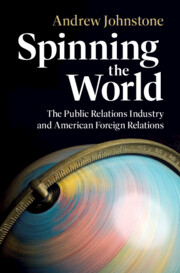Book contents
- Spinning the World
- Cambridge Studies in US Foreign Relations
- Spinning the World
- Copyright page
- Contents
- Acknowledgments
- Abbreviations
- Introduction
- 1 Progressive Origins
- 2 Defining an Industry
- 3 Conflicts of Interest
- 4 Promoting War and Peace
- 5 Shaping International Order
- 6 Aligning with Government
- 7 Developing American Business
- 8 Selling the World to America
- Epilogue
- Bibliography
- Index
2 - Defining an Industry
Public Theory and Private Practice
Published online by Cambridge University Press: 03 July 2025
- Spinning the World
- Cambridge Studies in US Foreign Relations
- Spinning the World
- Copyright page
- Contents
- Acknowledgments
- Abbreviations
- Introduction
- 1 Progressive Origins
- 2 Defining an Industry
- 3 Conflicts of Interest
- 4 Promoting War and Peace
- 5 Shaping International Order
- 6 Aligning with Government
- 7 Developing American Business
- 8 Selling the World to America
- Epilogue
- Bibliography
- Index
Summary
Chapter 2 examines the evolution of the new public relations industry in the 1920s and examines how that industry’s leaders built upon their wartime experiences to make links to foreign affairs. It examines how industry pioneers Edward Bernays and Ivy Lee justified their roles by building upon the work of Walter Lippmann. It looks at the earliest private efforts to work on foreign relations matters, such as Bernays’s efforts to promote American recognition of an independent Lithuania in 1919. It also examines Lee’s efforts to encourage American engagement with world affairs through the promotion of loans to European nations and his efforts to open up a dialogue with Russia. The latter interest led to questions about his motivations and allegations that he was a Soviet agent. The 1920s revealed that unlike during the war years, American PR firms did not always support America’s own interests.
Information
- Type
- Chapter
- Information
- Spinning the WorldThe Public Relations Industry and American Foreign Relations, pp. 39 - 61Publisher: Cambridge University PressPrint publication year: 2025
